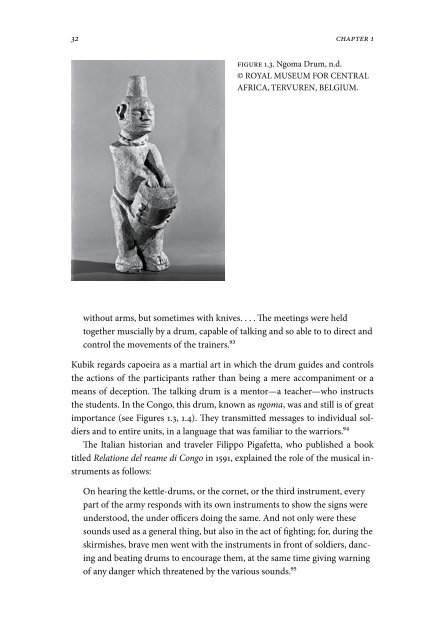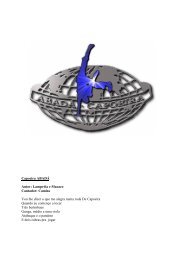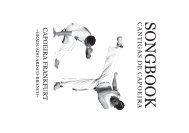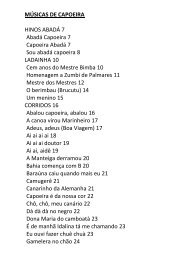- Page 2 and 3: The Hidden History of Capoeira
- Page 4 and 5: The Hidden History of Capoeira A Co
- Page 6 and 7: To my parents, Ruth and Dan, my hus
- Page 8 and 9: foreword ix acknowledgments xi intr
- Page 10 and 11: Foreword OVeR The pAST decade i hav
- Page 12: ACknowled gments ThIS BOOk, wRITTeN
- Page 15 and 16: THIS PAGE INTENTIONALLY LEFT BLANK
- Page 17 and 18: IntroductIon vantages of capoeira a
- Page 19 and 20: IntroductIon on the form. The incre
- Page 21 and 22: THIS PAGE INTENTIONALLY LEFT BLANK
- Page 23 and 24: chapter bique and Quilumana, Cabind
- Page 25 and 26: 0 chapter FIGuRe 1.2. São Salvador
- Page 27 and 28: chapter forbidden activities such a
- Page 29 and 30: chapter use of weapons and sticks;
- Page 31 and 32: 6 chapter MAp 1.1. The transatlanti
- Page 33 and 34: Table 1.3. Origin of Arrested Capoe
- Page 35 and 36: 0 chapter who hurled stones at the
- Page 37 and 38: chapter situation, whereupon the la
- Page 39 and 40: chapter Walsh expressed deep frustr
- Page 41 and 42: 6 chapter publicized. Luis da Costa
- Page 43 and 44: Blacks’ Games and Dances chapter
- Page 45: 0 chapter achieve physical and ment
- Page 49 and 50: FIGuRe 1.5. ngoma drummer in Headav
- Page 51 and 52: 6 chapter Capoeira and the Appeal t
- Page 53 and 54: chapter The colors of the hats and
- Page 55 and 56: 0 chapter FIGuRe 1.8. Warriors prep
- Page 57 and 58: FIGuRe 1.10. “‘play’ on dombi
- Page 59 and 60: chapter FIGuRe 1.13. Court of a Con
- Page 61 and 62: FIGuRe 1.15. Slaves Fighting (ca. 1
- Page 63 and 64: chapter around naked in the city st
- Page 65 and 66: 0 chapter Table 2.1. Origin of Arre
- Page 67 and 68: chapter mino was not a freedman, he
- Page 69 and 70: chapter status symbol. slaves tende
- Page 71 and 72: 6 chapter concluded that even harsh
- Page 73 and 74: chapter The most common street crim
- Page 75 and 76: 60 chapter MAp 2.1. The neighborhoo
- Page 77 and 78: 6 chapter ernment for their heroic
- Page 79 and 80: 6 chapter their anonymity in the cr
- Page 81 and 82: 66 chapter lice and soldiers. The f
- Page 83 and 84: 6 chapter strating their scorn and
- Page 85 and 86: 0 chapter were looking for solution
- Page 87 and 88: chapter • José ribeiro was arres
- Page 89 and 90: chapter constituting 56 percent of
- Page 91 and 92: 6 chapter rista performing in front
- Page 93 and 94: chapter MAp 3.2. nagoa and Guaiamu
- Page 95 and 96: 0 chapter prata [silver Birthmark]
- Page 97 and 98:
chapter the old oligarchy, especial
- Page 99 and 100:
chapter been fully and sadly confir
- Page 101 and 102:
6 chapter ponents of the republic.
- Page 103 and 104:
FIGuRe 3.4. a fight between two Cap
- Page 105 and 106:
0 chapter members of mixed blood, m
- Page 107 and 108:
chapter FIGuRe 3.8. Scenes of Magic
- Page 109 and 110:
chapter FIGuRe 3.9. Vendor of Arrud
- Page 111 and 112:
6 chapter FIGuRe 3.11. Man and Woma
- Page 113 and 114:
chapter FIGuRe 3.14. atabaque drum
- Page 115 and 116:
00 chapter FIGuRe 3.16. altar in Ba
- Page 117 and 118:
0 chapter rituals were described by
- Page 119 and 120:
0 chapter God,” evidence of the a
- Page 121 and 122:
06 chapter amulets were widely used
- Page 123 and 124:
0 chapter FIGuRe 3.18. solomon’s
- Page 125 and 126:
0 chapter it is a sign that solomon
- Page 127 and 128:
chapter ethic as a major value, a r
- Page 129 and 130:
chapter nevertheless, he also enume
- Page 131 and 132:
6 chapter leader, to welcome famous
- Page 133 and 134:
chapter was the political center wh
- Page 135 and 136:
0 chapter that also served as socia
- Page 137 and 138:
chapter This description is especia
- Page 139 and 140:
chapter in 1972 the federação Bra
- Page 141 and 142:
6 chapter the name of his school. p
- Page 143 and 144:
chapter contestants, crossing onese
- Page 145 and 146:
0 chapter FIGuRe 4.3. a player in t
- Page 147 and 148:
chapter pronounced like l, and the
- Page 149 and 150:
angolinha, angola angolinha eu vou
- Page 151 and 152:
6 chapter But different Capoeiras s
- Page 153 and 154:
chapter of the dead. This is eviden
- Page 155 and 156:
0 chapter and depends on the mood o
- Page 157 and 158:
chapter tors converge to the specia
- Page 159 and 160:
chapter around the world. Hence the
- Page 161 and 162:
6 chapter each in his way. some cro
- Page 163 and 164:
chapter movements but assured me th
- Page 165 and 166:
THIS PAGE INTENTIONALLY LEFT BLANK
- Page 167 and 168:
chapter ception of aesthetics, time
- Page 169 and 170:
A. disciplined training, B. respect
- Page 171 and 172:
6 chapter sion and a slow process o
- Page 173 and 174:
Part 2. CaPoeira today: angola and
- Page 175 and 176:
60 chapter and style.21 The respons
- Page 177 and 178:
6 chapter The day i shone in itabai
- Page 179 and 180:
6 chapter today members of capoeira
- Page 181 and 182:
66 chapter embodied in the aspirati
- Page 183 and 184:
6 chapter FIGuRe 5.3. The Chamada (
- Page 185 and 186:
0 chapter sei que eles falam desse
- Page 187 and 188:
chapter This, according to acordeon
- Page 189 and 190:
THIS PAGE INTENTIONALLY LEFT BLANK
- Page 191 and 192:
6 epIloGue to train and prepare for
- Page 193 and 194:
epIloGue and poor, thereby perpetua
- Page 195 and 196:
THIS PAGE INTENTIONALLY LEFT BLANK
- Page 197 and 198:
(rio de Janeiro: prefeitura da Cida
- Page 199 and 200:
noteS to paGeS - 0 24 in Karasch, S
- Page 201 and 202:
6 noteS to paGeS - 75 a. tierou, Do
- Page 203 and 204:
126 schlichthorst, O Rio de Janeiro
- Page 205 and 206:
0 noteS to paGeS 6 -66 48 Manuel Qu
- Page 207 and 208:
noteS to paGeS - 20 Vida Policial,
- Page 209 and 210:
noteS to paGeS - 0 tonian Movement,
- Page 211 and 212:
6 noteS to paGeS - 11 ibid., p. 69.
- Page 213 and 214:
noteS to paGeS - 63 Thompson, “Ca
- Page 215 and 216:
00 noteS to paGeS - 6 can dancers a
- Page 217 and 218:
THIS PAGE INTENTIONALLY LEFT BLANK
- Page 219 and 220:
0 GloSSary Ginga: Basic step of cap
- Page 221 and 222:
THIS PAGE INTENTIONALLY LEFT BLANK
- Page 223 and 224:
0 BIBlIoGraphy Correio Mercantil (r
- Page 225 and 226:
0 BIBlIoGraphy ajayi, folabo. “Ki
- Page 227 and 228:
BIBlIoGraphy ———. Religiões
- Page 229 and 230:
BIBlIoGraphy edmundo, Luíz. O Rio
- Page 231 and 232:
6 BIBlIoGraphy Krich, John. Why Is
- Page 233 and 234:
BIBlIoGraphy pastinha, Vicente ferr
- Page 235 and 236:
0 BIBlIoGraphy summ, Harvey. Brazil
- Page 237 and 238:
THIS PAGE INTENTIONALLY LEFT BLANK
- Page 239 and 240:
poeiras’ mocking of, 57, 61, 64,
- Page 241 and 242:
6 Index of, 151, 164-166, 172; teac
- Page 243 and 244:
disappearance, 104; and prayers, 14
- Page 245 and 246:
0 Index martial art distinguished f
- Page 247 and 248:
62, 75-76; An Electorate Bully, ; e
- Page 249 and 250:
eligious processions, and Capoeiras
- Page 251 and 252:
6 Index songs: and berimbaus, 140;






